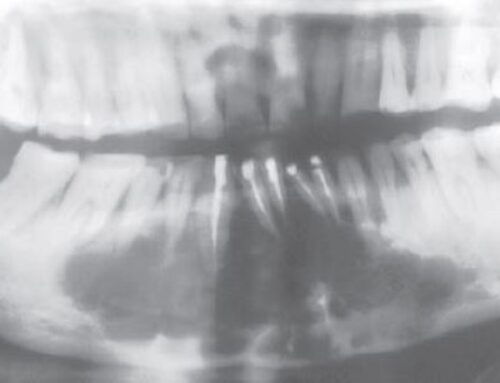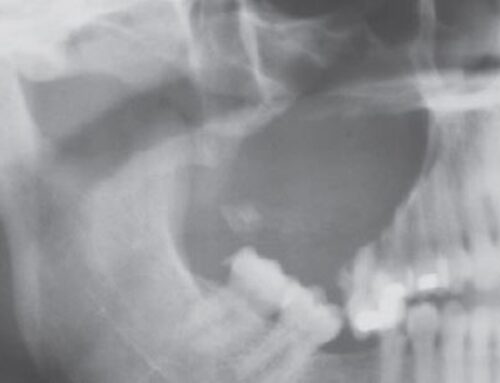Overview
- Slow growing, locally invasive tumors
- Relative frequency equals the combined frequency of all other odontogenic tumors, excluding odontomas
- Tumors arising from rests of dental lamina, from a developing enamel organ, from the epithelial lining of odontogenic cyst, or from the basal cells of the oral mucosa
- Not neurotrpic (do not invade nerve) but are neuroadherent, resulting in a possibility of tumor cells being left behind. One anatomic barrier would technically include epineurium.
- Three different clinicoradiographic situations
- Conventional solid or multicystic (about 86% of all cases)
- Unicystic (about 13% of all cases)
- Peripheral (extraosseous) (about 1 % of all cases)
Conventional Solid Or Multicystic Intraosseous Ameloblastoma
- Incidence: wide age range, rare in children <10, uncommon in children 10-19, equal prevalence in 3rd to 7th decade, no sex predilection
- Location: 80-85% occur in mandible; most in molar-ascending ramus; maxillary ameloblastomas occur in the posterior regions
- Clinical Features: often asymptomatic. Smaller lesions are detected only during a radiographic examination. A painless sweling or expansion of the jaw is the usual clinical presentation. Can grow slowly to massive proportions. Pain an paresthesia are uncommon.
- Radiographic Features: May appear unilocular with irregular scalloping. Multilocular radiolucent lesion often having “soap bubble” or “honeycomb” appearance. Buccal and lingual cortical expansion is often present. Resorption of teeth adjacent to the tumor is common. margins are irregularly scalloped
- Histopathology: Most tumors have cystic and solid features. Several microscopic subtypes of conventional ameloblastoma are recognized, but these microscopic patterns generally have litle bearing on the behavior of the tumor. Follicular and Plexiform are most common; Acanthomatous, Granular, Desmoplastic, Basal Cell are less common
- Treatment: The conventional ameloblastoma tends to infiltrate between intact cancellous bone trabeculae at the periphery of the lesion before bone resorption becomes radiographically evident. Therefore, the actual margin of the tumor often extends beyond its apparent radiographic or clinical margin. Attempts to remove the tumor by curettage often leave small islands of tumor within the bone, which later manifest as recurrences. Recurrence rates of 50-90% have been reported after curretage. resection with 1.0-1.5cm margins past the radiographic margins of the tumor.
Follicular Pattern
- Most common and recognized.
- Islands of epithelium resemble enamel organ epithelium in a mature fibrous connective tissue stroma. The epithelial nests consist of a core of loosely arranged angular cells resembling the stellate reticulum of an enamel organ. A single layer of tall columnar ameloblast-like cells surrounds this central core. The nuclei of these cells are located at the opposite pole to the basement membrane (reversed polarity)
- Islands of odontogenic epithelium bordered by columnar and palisaded ameloblastic cells with polarized hyperchromatic nuclei surrounding a stellate reticulum like central component
Plexiform Pattern
- Long, anastomosing cords or larger sheets of odontogenic epithelium. Cords or sheets of epithelium are bounded by columnar or cuboidal ameloblast-like cells surrounding more loosely arranged epithelial cells
- Supporting stroma tends to be loosely arranged and vascular. Cyst formation is uncommon; when it occurs, it is often associated with stromal degeneration
Acanthomatous Pattern
- When extensive squamous metaplasia, often associated with keratin formation, occurs in the central portions of the epithelial islands of a follicular ameloblastoma
- Lesion may be confused with squamous cell carcinoma or squamous odontogenic tumor
Granular Cell Pattern
- Transformation of groups of lesional epithelial cells to granular cells that have abutment cytoplasm filled with eosinophilic granules that resemble lysosomes
Desmoplastic Pattern
- Contains small islands and cords of odontogenic epithelium in a densely collagenized stroma
- Increased production of TGF-β which may be responsible for desmoplasia
- marked predilection for the anterior regions of the jaws, particularly the maxilla; resembles fibro-osseous lesions because of its mixed radiolucent and radiopaque appearance; mixed appearance is due to osseous metaplasia within the dense fibrous septa
Basal Cell Pattern
- least common type
- Composed of nests of uniform basaloid cells, and they are histopathologically similar to basal cell carcinoma of the skin
- No stellate reticulum is presents in the central portions of the nests
- The peripheral cells about the nests tend to be cuboidal rather than columnar
Unicystic Ameloblastoma
- Incidence: Account for 10-46% of all intraosseous ameloblastomas. 50% seen in 2nd decade, mean age 23
- Location: 90% in mandible, usually posterior region
- Clinical Features: Whether it originates de novo as a neoplasm or whether it is the result of neoplastic transformation of nonneoplastic cyst epithelium has been long debated
- Radiographic Features: circumscribed radiolucency that’s surrounds crown of unerupted tooth; may appear to have scalloped margins but is still unicystic
- Compare to: dentigerous cyst, primordial, radicular, residual
- Histopathology: Luminal, Intraluminal, Mural
- Treatment: enucleation and curettage for Luminal/Intraluminal; local resection if fibrous capsule invasion (Mural)
Luminal Unicystic Ameloblastoma
- Tumor is confined to the luminal surface of the cyst. The lesion consists of a fibrous cyst wall with a lining that consists ameloblastic epithelium. This demonstrates a basal layer of columnar or cuboidal cells with hyperchromatic nuclei that show reverse polarity and basilar cytoplasmic vacuolization. The overlying epithelial cells are loosely cohesive and resemble stellate reticulum
Intra-Luminal Unicystic Ameloblastoma
- One or more nodules of ameloblastoma project from the cystic lining into the lumen of the cyst
- The nodule can demonstrate edematous, plexiform pattern that resembles the plexiform pattern seen in conventional ameloblastoma – referred to as plexiform unicystic ameloblastoma
- Always accompanied by inflammation, which does not always meet the histopathology criteria of ameloblastoma
Mural Unicystic Ameloblastomas
- Fibrous wall of cyst is infiltrated by typical follicular or plexiform ameloblastoma



